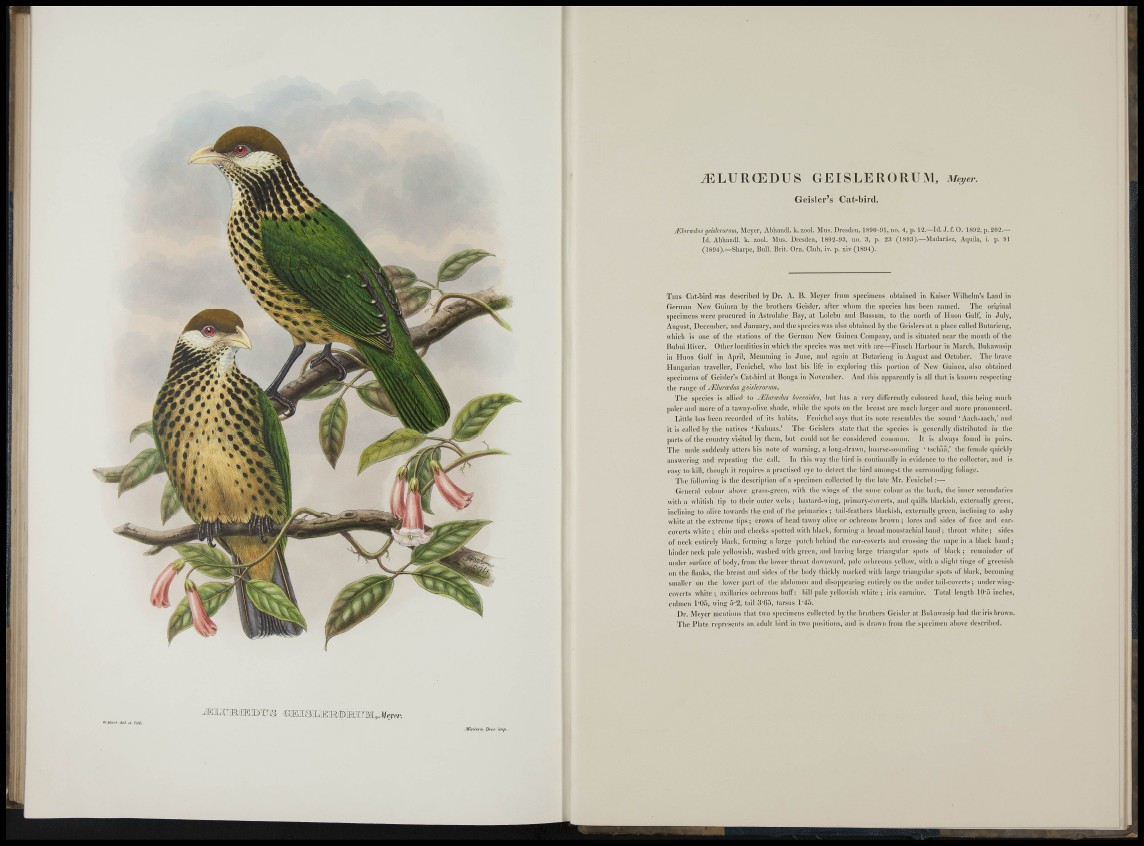
IV lOnI df l et l . f j ,
- d i ? , ] L T T R I I E ] I ] ) I I S (EEISZLlEIRiroffilTMg.tfevw-.
.Vin.tc/n lirvs ini}>.
^LURCEDUS GEISLERORUM, i»%er.
Geisler's Cat-bird.
Ailm-aius geiskromm, Meyer, Abliandl. k. zool. Mus. Dresden, 1880-91, no. 4, p. 12.—Id. J. f. 0 . 1892, p. 202.—
Id. Abhandl. k. zool. Mus. Dresden, 1892-93, no. 1), p. 23 (1893).—MadarSsz, Aquila, i. p. 91
(1894).—Sharpe, Bull. Brit. Orn. Club, iv. p. xiv (1894).
T H I S Cat-bird was described by Dr. A. B. Meyer from specimens obtained in Kaiser Willielm's Land in
German New Guinea by tiie brothers Geisler, after whom tlie species lias been named. The orijiinai
specimens were jiroeured in Astrolabe Bay, at Lolebu and Biissum, to the nortli of Hiion Gulf, in .Tuly,
August, December, and .January, and the sju'cies was also obtained by the Gelslers at a place called Butarieng,
which is one of the stations of the German New Guinea Company, and is situated near the mouth of the
Bubui Hiver. Other localities in which the species was met with are—Finsch Harbour in March, Bukawasip
in Huon Gulf in Ajiril, Meniniing in June, and again at Butarieng in August and October. The brave
Hungarian traveller, Fenichel, who lost his life in exploring this portion of New Guinea, also obtained
specimens of Geisler's Cat-bird at Bonga in November, And this apparently is all that is known re.speetiug
the range of /Elurmdus geislerorum.
Tlie species is allied to /Eluroeéis buccoides, but lias a very differently coloured head, this being much
])aler and more of a tawny-olive shade, while the spots on the breast are much larger and more |)roiiounced.
Little has been recorded of its habits. Feiiiehel says that its note resembles the sound * Aach-aaeli,' and
it is called by the natives ' Kubuas. ' The Geislers state that the species is generally distributed in the
])arts of the country visited by them, bat could not be considered common. It is always found in i)airs.
The male suddenly utters his note of warning, a long-drawn, hoarse-sounding ' tscbaa,' the female quickly
answering and repeating the call. In this way the bird is continually in evidence to the collector, and is
easy to kill, though it requires a practised eye to detect the bird among»t the surrouudi.ug foliage.
The following is the description of a specimcu collected by the late Mr. Fenichel :—
General colour above grass-green, with the ^^•ings of the same colour as the back, the inner secondaries
with a whitish tip to their outer webs; bastard-n ing, priLuary-coverts, and quills blackish, externally green,
inclining to olive towards the end of the ¡irimaries ; tail-feathers blackish, externally green, inclining to ashy
white at the extreme ti|)s ; crown of head tawny olive or oebreous brown ; lores and sides of face and earcoverts
white ; chin and cheeks spotted with black, forming a broad moastachial baud ; throat white; sides
of neck entirely black, forming a large patch behind (be ear-coverts and crossing the nape in a black band ;
hinder neck pale yellowish, washed with green, and having large triangular spots of black ; remainder of
under surface of bodv, from the lower throat downward, pale oebreous yellow, with a slight tinge of greenish
on the flanks, the breast and sides of the body thickly marked with large triangular sjjots of black, becoming
smaller on the lower ])art of the abdomen and disap¡)earlng entirely on the under tail-coverts; underwingcoverts
white ; axillaries oebreous buif: bill ¡)ale yellowish white ; iris earniine. Total length lO'O inches,
culmen I'Oo, wing 5-2, tail 3'O.j, tarsus 1'45.
Dr. Meyer mentions that two sj)ecimens collected by the brothers Geisler at Bukawasip had the iris brown.
The Flate represents an adult bird in two jiositions, and is di\iwn from the sjjccimeu above described.